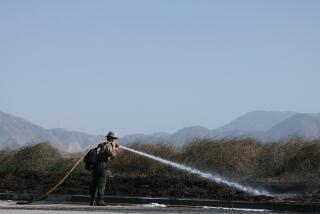Running hot and cold
As the Jesusita fire raged around Santa Barbara this week, Mitchell Sjerven decided to temporarily close his Seagrass restaurant near the normally bustling State Street.
The move to shutter the elegant “coastal cuisine” spot, where a “surf-and-turf” entree costs $48, could cost thousands of dollars.
On the opposite side of the street, just outside the border of the evacuation area, Sjerven’s intimate, French-inspired Bouchon restaurant picked up the slack by drawing a steady stream of hungry evacuees.
The fast-moving flames have already claimed dozens of homes and more than 1,000 acres in Santa Barbara’s scenic canyon neighborhoods. But while the area’s economy had already felt the sting by Thursday afternoon, business owners held out hope that the major retail centers would be spared.
What the flames might hold for this normally busy Mother Day’s weekend remained a puzzle. It was just too early and too dicey to predict, residents and fire officials said.
Santa Barbara County, known for its wine country and coastal beauty, may lose a chunk of its “billion-dollar” tourist trade, said Steve Cushman, president of the city’s Chamber of Commerce. Most visitors are Southern Californians who visit the area only for day trips and who will probably stay away until long after the fires die down, he said.
Already, the fire threat has closed tourist destinations such as Mission Santa Barbara and the Museum of Natural History.
The Santa Barbara Conference & Visitors Bureau canceled its annual tourism meeting because most of the 300 guests were too busy catering to evacuees to attend the Thursday afternoon event, said Sjerven, a board member.
“While Rome is burning, we don’t want to be seen as fiddling,” he said. So the group donated the luncheon to local firefighters.
But evacuees, numbering 13,000 and growing, could make up for the lost tourist revenue, he said.
His own home threatened by the flames, Cushman spent Wednesday night at a local hotel and ate out for dinner.
“I hate to say this, but so many people have been evacuated that there’ll be a positive impact on local businesses,” Cushman said.
Hotels, many of them offering deeply discounted rates, are packed with residents displaced from their homes. About 10 are already filled to capacity.
At Fess Parker’s DoubleTree Resort, about 170 of the 360 rooms are filled with local families, said general manager Matthew La Vine. Those guests are paying $129 a night, compared with the upper $200 range that is normal for the season.
An additional 50 rooms are occupied by firefighters. The hotel is sold out, in part because of its pet-friendly policy.
“We’re a business and we have to make a certain amount of money, and right now, we’re not making a bunch,” La Vine said. “But you have to be human once in a while -- at what point would you want to gouge somebody whose house just burned down?”
Locals staying with friends closer to the coast are thanking their benefactors by treating them to dinner at the city’s roughly 400 restaurants, Sjerven said, and bars are full of evacuees swapping fire stories.
“It’s not a groundswell like when we’re packed on Valentine’s Day,” he said. “But we’ll see additional traffic because these folks have to eat, and they’ll have to go out to do that.”
Meanwhile, large homeowner insurers such as Farmers Insurance Group and Allstate Corp. set up shop at the main evacuation center at Dos Pueblos High School in Goleta, handing out initial emergency payments to policyholders to cover hotel and restaurant bills.
“We’re fully armed and loaded. We’ve got our teams moving in,” said Bill Sirola, a spokesman for State Farm General Insurance Co., the state’s largest insurer of residential property.
But if the Santa Barbara blaze is anything like the big Southern California fires of 2007 and 2008, some policyholders may not have enough coverage to fully rebuild, warned Amy Bach, the executive director of San Francisco-based consumer group United Policyholders.
Meanwhile, retailers are on edge and local events remain a question mark.
“It’s smoky here, so people aren’t going out shopping,” Cushman said.
Shows this week at the Lobero Theatre featuring violinist Gilles Apap and Lily Tomlin have been postponed, with ticket holders being given the option to either switch dates or request a refund.
Peter Feldmann, owner of music promotion group BlueGrass West, abandoned a Thursday concert headlined by fiddler Byron Berline because the area around the Presidio Chapel venue was under evacuation warning. Aside from offering refunds for the $20 tickets, Feldmann also lost hundreds of dollars on the venue deposit and advertising.
“It’s not pleasant, but once in a while something like this happens and you just have to roll with it and hope for the best,” he said.
The Downtown Organization of Santa Barbara, a nonprofit business improvement group, called off its monthly first Thursday event after the fires caused power outages throughout downtown Wednesday. Evacuations meant that many of the merchants that would have participated were closed for the day. The organization lost up to $7,000 promoting the arts and culture affair.
For now, local companies are deeply nervous that the fire will breach the relative calm by stretching into Santa Barbara’s business district.
“It was pretty devastating last night, and today it’s a whole new game,” Cushman said Thursday. “If the fire comes down the canyons, it will be very hard to stop and it will come right into town.”
--
marc.lifsher@latimes.com
More to Read
Start your day right
Sign up for Essential California for news, features and recommendations from the L.A. Times and beyond in your inbox six days a week.
You may occasionally receive promotional content from the Los Angeles Times.








